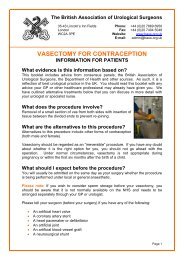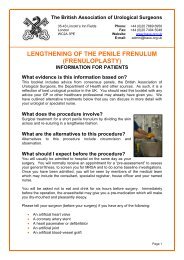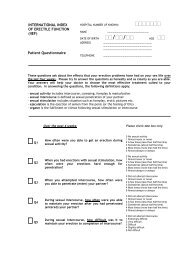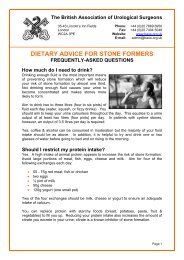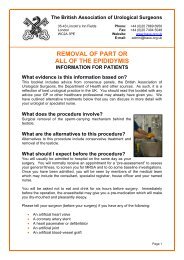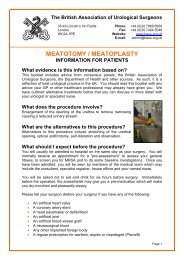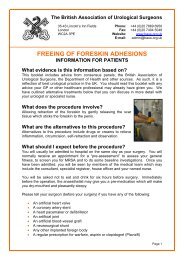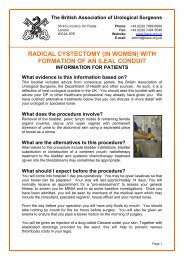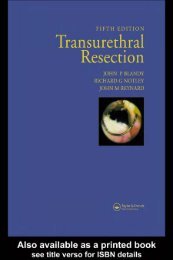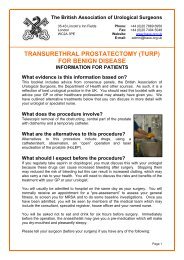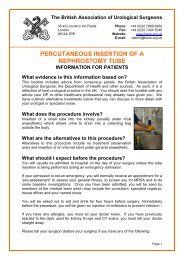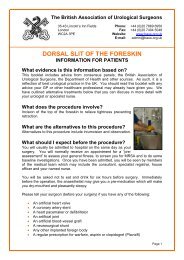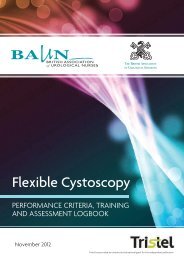MDT (multi-disciplinary team) guidance for managing prostate cancer
MDT (multi-disciplinary team) guidance for managing prostate cancer
MDT (multi-disciplinary team) guidance for managing prostate cancer
Create successful ePaper yourself
Turn your PDF publications into a flip-book with our unique Google optimized e-Paper software.
References<br />
1. Integrated Care Network. Integrated working: a guide. June, 2004. Available at: www.<br />
integratedcarenetwork.gov.uk/docs/publications/11/13.pdf.<br />
2. National Institute <strong>for</strong> Clinical Excellence. Guidance <strong>for</strong> commissioning <strong>cancer</strong> services. Improving<br />
outcomes in urological <strong>cancer</strong>s. The research evidence. London: NICE, 2002.<br />
3. House of Commons Committee of Public Accounts. The NHS Cancer Plan: a progress report.<br />
Twentieth report of session 2005−06. London: The Stationery Office, 2006.<br />
4. Davison BJ, Parker PA, Goldenberg SL. Patients’ preferences <strong>for</strong> communicating a <strong>prostate</strong> <strong>cancer</strong><br />
diagnosis and participating in medical decision-making. BJU Int 2004; 93: 47−51.<br />
5. Schroder FH, Hugosson Roobol MJ, et al. Screening and <strong>prostate</strong> <strong>cancer</strong> mortality in a randomized<br />
European study. N Engl J Med 2009; 360: 1320−1328.<br />
6. Andriole GL, Craw<strong>for</strong>d ED, Grubb RL 3rd, et al. Mortality results from a randomized <strong>prostate</strong><br />
<strong>cancer</strong> screening trial. N Engl J Med 2009; 360: 1310−1319.<br />
7. Rosario DJ, Lane JA, Metcalfe C, et al. Contribution of a single repeat PSA test to <strong>prostate</strong> cáncer<br />
risk assessment: experience from the ProtecT study. Eur Urol 2008; 53: 777−784.<br />
8. Ben-Shlomo Y, Evans S, Ibrahim F, et al. The risk of <strong>prostate</strong> <strong>cancer</strong> amongst black men in the<br />
United Kingdom: the PROCESS cohort study. Eur Urol 2008; 53: 99−105.<br />
9. Steinberg GD, Carter BS, Beaty TH, Childs B, Walsh PC. Family history and the risk of <strong>prostate</strong><br />
<strong>cancer</strong>. Prostate 1990; 17: 337−347.<br />
10. Negri E, Pelucchi C, Talamini R, et al. Family history of <strong>cancer</strong> and the risk of <strong>prostate</strong> <strong>cancer</strong> and<br />
benign prostatic hyperplasia. Int J Cancer 2005; 114: 648−652.<br />
11. Catalona WJ, Richie JP, DeKernion JB, et al. Comparison of <strong>prostate</strong> specific antigen concentration<br />
versus <strong>prostate</strong> specific antigen density in the early detection of <strong>prostate</strong> <strong>cancer</strong>: Receiver<br />
operating characteristic curves. J Urol 1994; 152 (6 Pt 1): 2031−2036.<br />
12. Elgamal A-AA, Cornillie FJ, Van Poppel HP, et al. Free-to-total <strong>prostate</strong> specific antigen ratio as a<br />
single test <strong>for</strong> detection of significant stage T1c <strong>prostate</strong> <strong>cancer</strong>. J Urol 1996; 156: 1042−1049.<br />
13. Aus G, Becker C, Lilja H, et al. Free-to-total <strong>prostate</strong>-specific antigen ratio as a predictor of nonorgan-confined<br />
<strong>prostate</strong> <strong>cancer</strong> (stage pT3). Scand J Urol Nephrol 2003; 37: 466−470.<br />
14. Aus G, Becker C, Franzen S, et al. Cumulative <strong>prostate</strong> <strong>cancer</strong> risk assessment with the aid of the<br />
free-to-total <strong>prostate</strong> specific antigen ratio. Eur Urol 2004; 45: 160−165.<br />
15. Hudson MA, Bahnson RR, Catalona WJ. Clinical use of <strong>prostate</strong> specific antigen in patients with<br />
<strong>prostate</strong> <strong>cancer</strong>. J Urol 1989; 142: 1011−1017.<br />
16. Brawer MK, Lange PH. Prostate-specific antigen in management of prostatic carcinoma. Urology<br />
1989; 33 (5 Suppl): 11−16.<br />
17. Partin AW, Carter HB, Chan DW, et al. Prostate specific antigen in the staging of localized <strong>prostate</strong><br />
<strong>cancer</strong>: influence of tumor differentiation, tumor volume and benign hyperplasia. J Urol 1990;<br />
143: 747−752.<br />
18. Dearnaley DP, Kirby RS, Kirk D, Malone P, Simpson RJ, Williams G. Diagnosis and management of<br />
early <strong>prostate</strong> <strong>cancer</strong>. Report of a British Association of Urological Surgeons working party. BJU Int<br />
1999; 83: 18−33.<br />
19. DeAntoni EP, Craw<strong>for</strong>d ED, Oesterling JE, et al. Age- and race-specific reference ranges <strong>for</strong><br />
<strong>prostate</strong>-specific antigen from a large community-based study. Urology 1996; 48: 234−239.<br />
20. Xu ZQ, Hua LX, Qian LX, Wu HF. Effect of transrectal prostatic biopsy on serum <strong>prostate</strong>-specific<br />
antigen levels. Zhonghua Nan Ke Xue 2002; 8: 341−342.<br />
52



